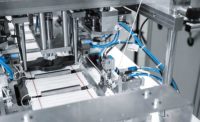Systems Integrator takes diverse approach to medical device assembly systems

Robots assemble sensors used for diagnosing heart attacks. Photo courtesy Evana Automation Specialists
There are many ways to run a custom machine building business. Some systems integrators are dedicated to a particular industry, such as auto parts manufacturing. Others specialize in a particular kind of assembly machine, such as high-speed continuous motion systems. And some are generalists, serving multiple industries and designing many types of systems.
Evana Automation Specialists in Evansville, IN, takes the latter approach. The company has built assembly and test systems for manufacturers all over the world for such industries as automotive, aerospace, defense and alternative energy. The company has built multistation automated assembly lines, both synchronous and nonsynchronous, as well as standalone workstations and lean cells.
In the past two years, the company has designed several assembly systems for medical device manufacturers.
One project involved a manufacturer of health monitoring products. Evana built two automated assembly systems that produce “cardiac panel” sensors more quickly, efficiently and economically than the company’s previous assembly process.
A cardiac panel is a series of blood tests that help physicians quickly determine if a patient has had a heart attack or stroke. The sensors are used with an analyzer to provide results of these tests within minutes, enabling treatment to be implemented immediately.
Each assembly system manufactures the sensors at a cycle rate of two seconds, part-to-part. The assembly process begins by automatically loading the sensor body from a magazine feeder onto a conveyor.
From there, the sensor body travels through 11 automatic assembly stations. The stations consist of precision inking stations, which precisely dispense and place lines of ink to direct the blood flow; spray stations, which disperse diagnostic chemicals; drying stations; a filter placement station; a lid placement and welding station; and a label application station.
Error-proofing and traceability methods are employed throughout the assembly process to ensure the quality and integrity of the sensors.
Evana took a different tack with a project to assemble a catheter.
A catheter adapter, connector and O-ring are automatically fed to a robotic assembly cell. A robot picks up the three parts and places them on a nest atop a two-position rotary-indexing dial. With each index, a driver rotates the adapter onto the connector. The finished part is then dropped into a bulk container.
The system can run many different configurations. The nests on the dial can be quickly exchanged. Each feeder bowl contains a cover that is locked in position. The operator scans the parts to be loaded, and the system verifies that they are the correct parts to be processed. If so, the lid unlocks, and the operator loads the parts. A vision system verifies correct placement of the O-ring.
“Evana’s robotic assembly cell will help error-proof the process of assembling catheter parts,” says Randy Wire, general manager of Evana Automation.
A third project involved a robotic material handling system for a medical device manufacturer. The system transports wire-shaping fixtures to heat-treating furnaces, a quenching station, and the final assembly line.
Operators load the wire-shaping fixtures into part nests, which hold multiple fixtures. A robot picks up the nest and loads it into one of several furnaces. The robot then removes a nest from the furnace and places it into a quenching station. Sensors confirm that fixtures have entered and left the furnace.
After quenching, the fixtures are transported, via robot, to a conveyor that feeds them to operators for final assembly.
“Evana’s robotic material handling system will reduce labor and increase safety in a potentially hazardous environment,” says Wire.
For more information, call Evana Automation at 800-468-6774 or visit www.evanaautomation.com.
Looking for a reprint of this article?
From high-res PDFs to custom plaques, order your copy today!






